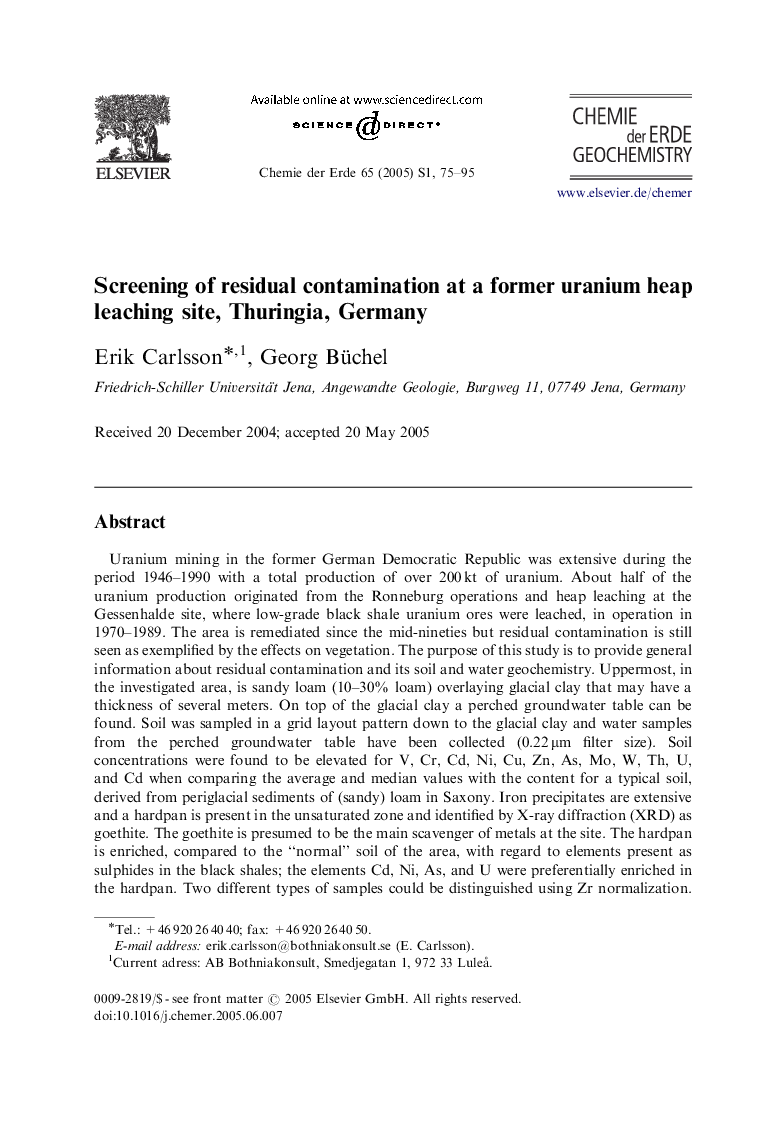| کد مقاله | کد نشریه | سال انتشار | مقاله انگلیسی | نسخه تمام متن |
|---|---|---|---|---|
| 9451168 | 1307377 | 2005 | 21 صفحه PDF | دانلود رایگان |
عنوان انگلیسی مقاله ISI
Screening of residual contamination at a former uranium heap leaching site, Thuringia, Germany
دانلود مقاله + سفارش ترجمه
دانلود مقاله ISI انگلیسی
رایگان برای ایرانیان
کلمات کلیدی
موضوعات مرتبط
مهندسی و علوم پایه
علوم زمین و سیارات
ژئوشیمی و پترولوژی
پیش نمایش صفحه اول مقاله

چکیده انگلیسی
Uranium mining in the former German Democratic Republic was extensive during the period 1946-1990 with a total production of over 200 kt of uranium. About half of the uranium production originated from the Ronneburg operations and heap leaching at the Gessenhalde site, where low-grade black shale uranium ores were leached, in operation in 1970-1989. The area is remediated since the mid-nineties but residual contamination is still seen as exemplified by the effects on vegetation. The purpose of this study is to provide general information about residual contamination and its soil and water geochemistry. Uppermost, in the investigated area, is sandy loam (10-30% loam) overlaying glacial clay that may have a thickness of several meters. On top of the glacial clay a perched groundwater table can be found. Soil was sampled in a grid layout pattern down to the glacial clay and water samples from the perched groundwater table have been collected (0.22 μm filter size). Soil concentrations were found to be elevated for V, Cr, Cd, Ni, Cu, Zn, As, Mo, W, Th, U, and Cd when comparing the average and median values with the content for a typical soil, derived from periglacial sediments of (sandy) loam in Saxony. Iron precipitates are extensive and a hardpan is present in the unsaturated zone and identified by X-ray diffraction (XRD) as goethite. The goethite is presumed to be the main scavenger of metals at the site. The hardpan is enriched, compared to the “normal” soil of the area, with regard to elements present as sulphides in the black shales; the elements Cd, Ni, As, and U were preferentially enriched in the hardpan. Two different types of samples could be distinguished using Zr normalization. This was interpreted as soil with more or less extensive Fe precipitation. Dissolved Fe concentration is in most cases low, an indication that the Fe precipitates are stable under the current environmental conditions. Water concentrations for many elements (e.g. Ni, Cu, Zn, Al, F, Pb, and U) strongly correlated with decreasing pH. In the future, the situation in this area with regard to soil and water contamination will improve due to the ongoing wash out and the limited pool of residual contaminants.
ناشر
Database: Elsevier - ScienceDirect (ساینس دایرکت)
Journal: Chemie der Erde - Geochemistry - Volume 65, Supplement 1, 19 September 2005, Pages 75-95
Journal: Chemie der Erde - Geochemistry - Volume 65, Supplement 1, 19 September 2005, Pages 75-95
نویسندگان
Erik Carlsson, Georg Büchel,